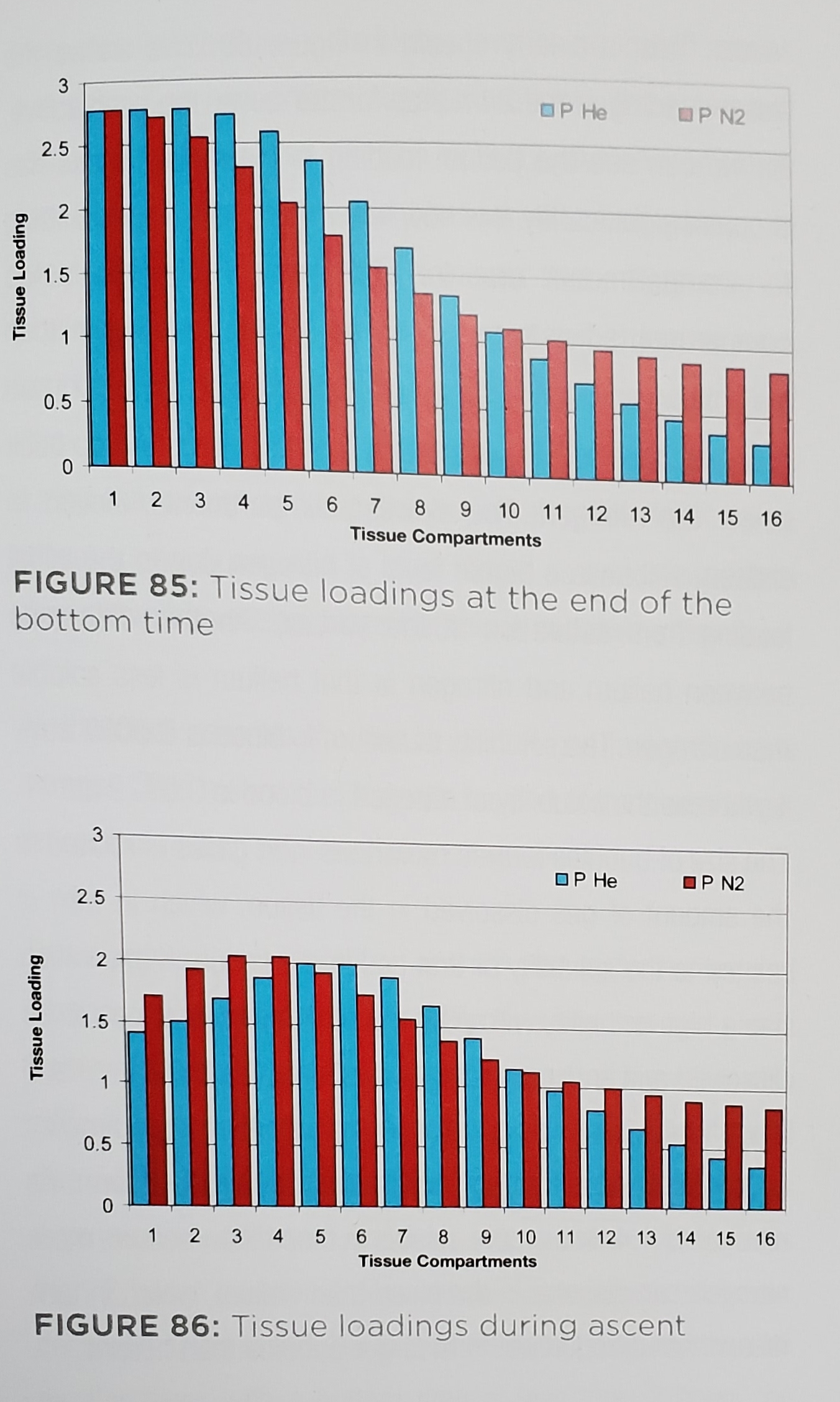Ryan Neely
Contributor
As the title suggests, I'm working my way through Mark Powell's Deco for Divers. It's a fabulous book that makes for a great introduction to decompression theory.
I'm closing in on the end of the book and have reached the section where he discusses trimix. In this section, there is a graph he uses to illustrate the different rates at which helium and nitrogen on-gas and off-gas.
I think I'm understand what he's saying here, but the graph seems to be missing a key element which would make understanding what is happening here more . . . intuitive.
So, first, here's the graph:
Next, here is the excerpt from the book illustrating the purpose of the graph:
". . . Figure 85 . . . represents tissue loadings for helium and nitrogen. These loadings are for a 60m dive for 40 minutes using 20/40. . . . We can see that compartments one to three are saturated with helium and compartment four is very close. In contrast only compartment 1 is saturated with nitrogen and all the others are at a lower level of saturation. We can also see that in most of the compartments the level of helium loading is higher than the level of nitrogen loading. The exception to this is the slower compartments eleven to sixteen. The reason for this is that all compartments already have a nitrogen loading from being saturated with nitrogen at the surface, but do not have any helium loading. [Emphasis mine.]"
I was confused by this at first because the excerpted explanation that accompanies the graph seemed to be suggesting (correctly) that tissues were already loaded with nitrogen from being on the surface, which my mind took to mean saturated. This immediately sent my mind spiraling down a rabbit hole, trying to understand how a tissue already saturated from breathing air (as any normal human being would) at the surface wouldn't already be an issue for any dive.
I realize now this was not correct.
What I think is missing from the graph that would have made my understanding easier is a label along the Y-axis which indicates that the numbers there represent partial pressure (either in atm or bar).
Because the graph represents the end of the dive's bottom time, it now appears to me that the slower tissues (especially tissue sixteen) is still sitting at a partial pressure of close to 0.79 atm or bar (or whatever the necessary unit for what the graph represents).
I just want to make sure I'm not misunderstanding something here, because (as I mentioned) I was starting to go down a tangent that completely upended my entire understanding of diving.
Any additional thoughts would be helpful.
Thank you.
I'm closing in on the end of the book and have reached the section where he discusses trimix. In this section, there is a graph he uses to illustrate the different rates at which helium and nitrogen on-gas and off-gas.
I think I'm understand what he's saying here, but the graph seems to be missing a key element which would make understanding what is happening here more . . . intuitive.
So, first, here's the graph:
Graph from Deco for Divers
This is a graph pulled from Mark Powell's Deco for Divers which illustrates the different rate...
Next, here is the excerpt from the book illustrating the purpose of the graph:
". . . Figure 85 . . . represents tissue loadings for helium and nitrogen. These loadings are for a 60m dive for 40 minutes using 20/40. . . . We can see that compartments one to three are saturated with helium and compartment four is very close. In contrast only compartment 1 is saturated with nitrogen and all the others are at a lower level of saturation. We can also see that in most of the compartments the level of helium loading is higher than the level of nitrogen loading. The exception to this is the slower compartments eleven to sixteen. The reason for this is that all compartments already have a nitrogen loading from being saturated with nitrogen at the surface, but do not have any helium loading. [Emphasis mine.]"
I was confused by this at first because the excerpted explanation that accompanies the graph seemed to be suggesting (correctly) that tissues were already loaded with nitrogen from being on the surface, which my mind took to mean saturated. This immediately sent my mind spiraling down a rabbit hole, trying to understand how a tissue already saturated from breathing air (as any normal human being would) at the surface wouldn't already be an issue for any dive.
I realize now this was not correct.
What I think is missing from the graph that would have made my understanding easier is a label along the Y-axis which indicates that the numbers there represent partial pressure (either in atm or bar).
Because the graph represents the end of the dive's bottom time, it now appears to me that the slower tissues (especially tissue sixteen) is still sitting at a partial pressure of close to 0.79 atm or bar (or whatever the necessary unit for what the graph represents).
I just want to make sure I'm not misunderstanding something here, because (as I mentioned) I was starting to go down a tangent that completely upended my entire understanding of diving.
Any additional thoughts would be helpful.
Thank you.





